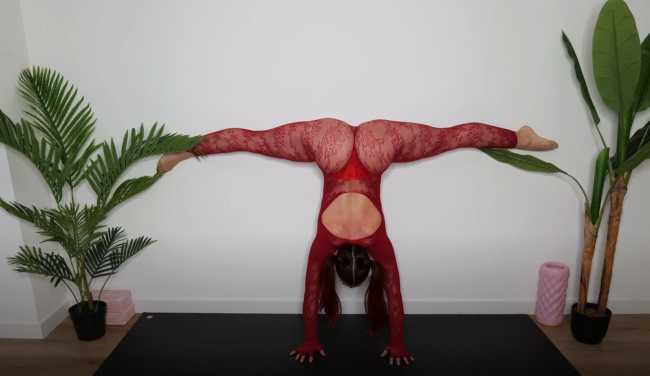
In the age of social media, fitness trends come and go like waves. One day, everyone is obsessed with a new plank challenge, and the next, it’s all about high-intensity interval training or dance workouts. But one particular trend caught my eye recently—a stretching routine that went viral for its promise to improve flexibility, reduce soreness, and even enhance posture in just a few weeks. As someone who often struggles with stiff hips and tight shoulders from long hours at the desk, I decided to give this viral stretching routine a try and see if it lived up to the hype.
Why I Wanted to Try It
I’ve never been the most flexible person. I can’t remember the last time I touched my toes without bending my knees, and any attempt to do the splits feels like I’m about to tear something. So, when I saw video after video of people praising this stretching routine for its “miracle” results, I was intrigued. Influencers claimed they went from barely reaching past their knees to touching their toes or even achieving full splits in just a few weeks.
The routine also promised mental benefits—reducing stress, improving focus, and promoting better sleep. Since I’ve been working from home and feeling more tense than usual, I figured this was the perfect opportunity to experiment.

The Viral Stretching Routine
The routine itself was simple yet intense. It only took 15–20 minutes per day, but it targeted every major muscle group. Here’s a breakdown of what the routine involved:
- Forward Fold (1 minute) – Standing with feet hip-width apart, I would slowly hinge forward, letting my arms dangle toward the floor. This stretch focused on hamstrings and lower back.
- Deep Lunge Stretch (1 minute per side) – Starting in a runner’s lunge, this stretch opened my hip flexors, which are notoriously tight from sitting.
- Seated Butterfly Stretch (2 minutes) – Sitting on the ground with my feet together and knees falling out, I’d hold my feet and lean forward slightly. This one was intense on my inner thighs.
- Spinal Twist (1 minute per side) – A seated twist that helped loosen up my spine and relieve back tension.
- Cat-Cow Stretch (2 minutes) – A dynamic movement between arching and rounding the back, improving spinal flexibility.
- Cobra Pose (1 minute) – Lying on my stomach and pressing my upper body up, this stretched my abdominal muscles and opened my chest.
- Child’s Pose (2 minutes) – A resting stretch for the back, shoulders, and hips.
- Pancake Stretch (2 minutes) – Sitting with legs spread wide, I leaned forward to stretch hamstrings and inner thighs.
- Neck and Shoulder Rolls (1 minute) – Gentle movements to release upper-body tension.
It didn’t sound like much, but doing these stretches in sequence felt like a full-body reset.
My First Attempt
The first day was humbling. I realized just how tight my body was. The forward fold felt impossible—I could only reach my shins. The butterfly stretch burned my inner thighs, and the pancake stretch was brutal. I kept glancing at the timer, hoping the minute would pass faster.
But something unexpected happened as I finished the session. My body felt lighter, and I noticed a warmth in my muscles. It wasn’t painful; it was like my body was waking up. That night, I also slept like a baby. I hadn’t realized how much tension I’d been carrying.

The First Week
After doing the routine for a full week, I started noticing small but encouraging changes. My hamstrings felt looser, and I could fold forward a little farther each day. I wasn’t anywhere near the splits, but I was making progress.
The mental benefits were just as noticeable. The 15 minutes I spent stretching each day became my “me time,” a chance to disconnect from screens and focus on my breathing. It felt almost meditative, especially during the slower stretches like child’s pose or the spinal twist.
I also felt less sore after workouts. Normally, after a run or leg day, I’d wake up with stiffness. But the daily stretches seemed to reduce that post-workout discomfort.
The Second Week – Visible Progress
By the second week, I was hooked. My forward fold improved so much that I could actually touch the tops of my feet without bending my knees—a huge win for me! My hips felt more open, which made sitting cross-legged much easier.
I also noticed that my posture improved. Spending hours hunched over my laptop had rounded my shoulders, but the cobra pose and shoulder rolls helped counteract that. I felt taller and more confident just walking around.
One of the best surprises was how much better my lower back felt. I’ve always had a bit of tightness there, but the combination of hip stretches and spinal twists provided real relief.

Challenges Along the Way
Of course, it wasn’t all easy. Some days I felt unmotivated or too tired to stretch. But I reminded myself that it was just 15 minutes, and once I started, I always felt better afterward.
Another challenge was the deep lunge stretch—it was particularly painful in the beginning, especially on my right side. I had to use yoga blocks for support until I gained more flexibility.
Final Thoughts – Was It Worth It?
After three weeks of consistently following the viral stretching routine, I can confidently say it was worth every minute. My flexibility improved noticeably, and I feel stronger and more agile. While I’m not ready to post a splits video on TikTok just yet, I’ve made enough progress to know that stretching works wonders when done regularly.
The routine also helped me develop a new habit—listening to my body. I now pay attention to areas of tightness and take time to stretch them out rather than ignoring them.
Perhaps the biggest lesson I learned is that stretching isn’t just about flexibility; it’s about overall wellness. It improved my posture, reduced stress, and gave me a sense of calm at the end of busy days.
Would I Recommend It?
Absolutely! Whether you’re a fitness enthusiast, an office worker, or someone who just wants to feel less stiff, this viral stretching routine is worth trying. You don’t need fancy equipment or a gym membership—just a mat, some patience, and consistency.
The beauty of this routine is that it’s scalable. If you’re a beginner, you can modify the stretches with pillows or blocks. If you’re more advanced, you can hold each position longer or go deeper into the stretches.
What’s Next for Me?
Now that I’ve seen how much better I feel from 15 minutes of daily stretching, I plan to keep it as part of my routine. I’m even considering adding yoga sessions to deepen my flexibility and build strength simultaneously.
Stretching has gone from being an afterthought to being a cornerstone of my fitness journey. And who knows—maybe one day, I’ll be that person posting my own “before and after” splits video!
Final Word: If you’re curious about whether a viral stretching routine is worth the hype, my answer is yes. The key isn’t magic—it’s consistency. Commit to just a few minutes each day, and you’ll be surprised at how your body rewards you.


